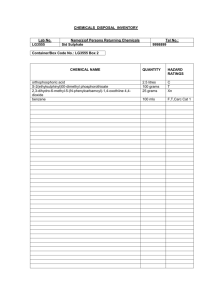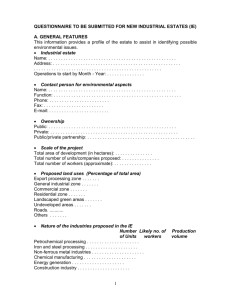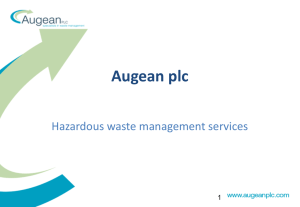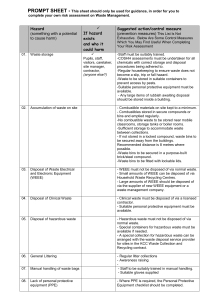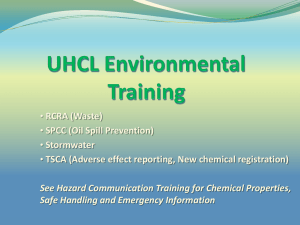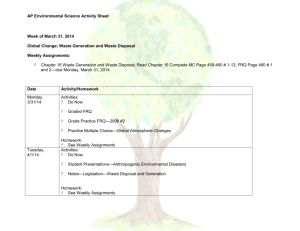School Process for Disposing of Waster Chemicals - OISE
advertisement
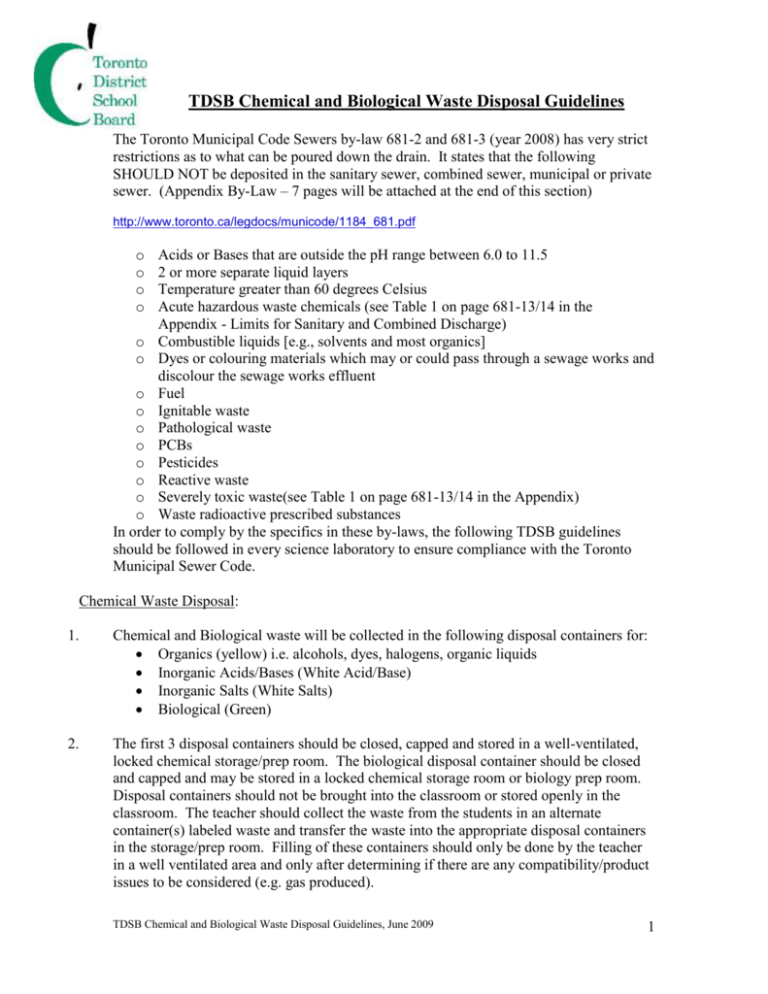
TDSB Chemical and Biological Waste Disposal Guidelines The Toronto Municipal Code Sewers by-law 681-2 and 681-3 (year 2008) has very strict restrictions as to what can be poured down the drain. It states that the following SHOULD NOT be deposited in the sanitary sewer, combined sewer, municipal or private sewer. (Appendix By-Law – 7 pages will be attached at the end of this section) http://www.toronto.ca/legdocs/municode/1184_681.pdf o o o o Acids or Bases that are outside the pH range between 6.0 to 11.5 2 or more separate liquid layers Temperature greater than 60 degrees Celsius Acute hazardous waste chemicals (see Table 1 on page 681-13/14 in the Appendix - Limits for Sanitary and Combined Discharge) o Combustible liquids [e.g., solvents and most organics] o Dyes or colouring materials which may or could pass through a sewage works and discolour the sewage works effluent o Fuel o Ignitable waste o Pathological waste o PCBs o Pesticides o Reactive waste o Severely toxic waste(see Table 1 on page 681-13/14 in the Appendix) o Waste radioactive prescribed substances In order to comply by the specifics in these by-laws, the following TDSB guidelines should be followed in every science laboratory to ensure compliance with the Toronto Municipal Sewer Code. Chemical Waste Disposal: 1. Chemical and Biological waste will be collected in the following disposal containers for: Organics (yellow) i.e. alcohols, dyes, halogens, organic liquids Inorganic Acids/Bases (White Acid/Base) Inorganic Salts (White Salts) Biological (Green) 2. The first 3 disposal containers should be closed, capped and stored in a well-ventilated, locked chemical storage/prep room. The biological disposal container should be closed and capped and may be stored in a locked chemical storage room or biology prep room. Disposal containers should not be brought into the classroom or stored openly in the classroom. The teacher should collect the waste from the students in an alternate container(s) labeled waste and transfer the waste into the appropriate disposal containers in the storage/prep room. Filling of these containers should only be done by the teacher in a well ventilated area and only after determining if there are any compatibility/product issues to be considered (e.g. gas produced). TDSB Chemical and Biological Waste Disposal Guidelines, June 2009 1 3. The disposal containers should not be filled past the 10L mark. 4. All teachers should: Know the location of the disposal containers Include a safety component in their lesson plan that clearly outlines for every laboratory activity, the chemicals being used and waste produced (chemical/solution names, concentrations, and amounts) Know which chemicals & waste materials go in which disposal container 5. All unused chemicals and waste material generated in a laboratory experiment must be collected by the teacher and disposed of in the appropriate waste and disposal containers. Students/teachers should not put any excess chemicals or chemical waste down the drain, in garbage cans, nor return them to the stock bottles. 6. Acid and Bases should be disposed of in the white inorganic acids/bases disposal containers, labeled Inorganic Acids/Bases. The name of the acid or base placed in the container should be noted on the disposal container’s label. No concentrated acid/base should be placed directly in the container; it should first be diluted to 6 mol/L or lower. (Caution: heat may be generated from the addition of the acid/base to the solution in the container.) 7. Salt solutions should be disposed of in the white inorganic salts solution disposal containers. The name of the salt solution placed in the container should be noted on the disposal container’s label. 8. A yellow disposal container (for organic compound disposal) should be available in the chemical storage room. Any mixture that contains even small amounts of organic compounds, solid or liquid, must be placed in the yellow bin. 9. All biological stains and dyes should be collected and disposed of in the appropriate disposal container (yellow), and CAN NOT be poured down the drain. (Caution: some organic reagents are oxidizers/reducers.) 10. Filter paper with heavy metal residue should be placed in a double zip lock bag for collection by the Health & Safety Department. 11. Equipment and glassware that has been in contact with chemicals should be washed with lots of running water and these minimal amounts of chemicals may go down the drain. 12. Original chemical containers or jars should be empty of all contents and labels removed or defaced with a black marker prior to being thrown in the general garbage. These empty containers should be thrown in the garbage can located in the chemical storage room rather than classroom garbage cans. If unused chemicals and/or residual chemical wastes remain, keep the chemical in the original container with the lid/cap closed, complete OH & S disposal request form and await pick up by the Health & Safety Department. TDSB Chemical and Biological Waste Disposal Guidelines, June 2009 2 13. Broken glassware should be disposed of in the broken glass container in each classroom. When these containers are full and need to be disposed of, broken glass should be transferred to a cardboard box. The lid or the top of the box should be securely fastened, and the box should be clearly labeled “Broken Laboratory Glassware for Disposal”. This box should then be taken to the school’s caretaker area, and the caretaker should dispose of this box in the large garbage bins. OR, broken glassware should be wrapped in newspaper, taped and labeled “Broken Glass” and should be disposed of as regular garbage. Dissection Waste Disposal: 14. The liquids should be kept (not poured down the drain) and the animal remains placed back into the liquids, and disposed of in the green disposal containers. (There is a procedure in the STAO’s Stay Safe! Manual, page 44, for biological disposal material that doesn’t apply to the TDSB. In the TDSB, dissection waste material should NOT be double bagged and disposed of as ordinary garbage, unless it is freeze dried). 15. For pick up of these disposal waste containers: Complete Hazardous Waste form (can be downloaded from Science.TEL, Connected Teacher, and Tdsbweb: Health & Safety). Specify the colour of the container(s) for pickup Call 416-397-3210 for pickup Disposal containers should be picked up at least once a term or semester New containers will be left each time one is picked up. If you are in a large school, several containers may be requested at the same time. (Write request on the Hazardous Waste form.) If you have any questions, please call the Health & Safety Office at 416-397-3210. The neutralization Alternative: If you feel confident with the process of neutralization of acid/base solutions, you MUST follow and meet these clearly outlined guidelines (chemicals with a pH less than 6 or greater than 11.5 cannot be disposed of down the drain), in order to ensure compliance of the 681-2 and 681-3 (year 2008) by-laws (see appendix attached) Only teachers NOT students should neutralize acids and bases to be poured down the drain. 16. Recommended methods for neutralization of acids/bases: a) Check the pH of the acid/base solution with universal indicator paper or solution. If the pH is between 6 and11.5 the solution can then be poured down the drain and flushed with lots of water so that it does not remain in the trap. TDSB Chemical and Biological Waste Disposal Guidelines, June 2009 3 If the pH is greater than 11.5 or less than 6, then use the following methods to neutralize the acid/base solutions b) For bases, add acid and use universal indicator to get the pH between 6 and 11.5. The solution can now go down the drain (with plenty of water). c) For acids, add sodium bicarbonate (baking soda) slowly to the acid until it stops fizzing (releasing CO2). Keep adding baking soda until some solid sodium bicarbonate settles on the bottom of the container even after stirring. The solution can now go down the drain. Alternatively, you may use a universal indicator and add a strong base component. d) Using a hand-held pH meter, add the appropriate solution until the reading on the pH meter is between 6 and11.5. The solution can now go down the drain (with plenty of water). References: STAO’s Stay Safe!: page 43 except do not follow this reference’s suggestion for dissection waste material (see section on Biological Waste). Note that the ScholARTM Chemistry references to Hazardous Waste disposal are based on the US laws and regulations. XIV 1-13 TDSB Chemical and Biological Waste Disposal Guidelines, June 2009 4


